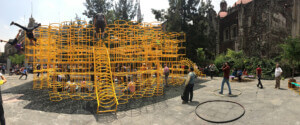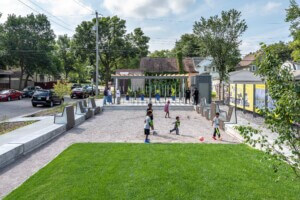This article is part of our series of profiles on The Architectural League of New York’s 2024 Emerging Voices winners published in the March/April issue of AN. The full list of winners can be found here.
Neeraj Bhatia’s architectural practice draws on the philosophy of Hannah Arendt. “My work is aligned with her definition of power: Power is derived from people speaking and acting in concert, and dissipates when they choose not to,” he told AN. For Bhatia, this attitude toward power provides hope for architects practicing under the pressures and crises of our time, but it also has allowed his studio, The Open Workshop, to create a new kind of power within practice.
Bhatia has become synonymous with collective design movements. From projects at the Chicago and Venice biennials to a recent book, New Investigations in Collective Form, The Open Workshop proposes “frameworks” and “choreographies” that re-present what agency and values can look like today. “The benefits go way beyond just sharing resources,” he said. Collective living strategies are poised not only to combat the effects of the housing, climate, and affordability crises but also to offer more robust systems of care, solidarity, and social resilience.

While The Open Workshop’s ideals can seem quite lofty, the very rigorous (and beautiful) work that happens there grounds these goals in accessible language. Inspired by radical newspapers, the studio created a series of broadsheets to spread information about mutual-aid groups in Chicago’s Bronzeville neighborhood and created installations that put viewers in a worm’s-eye-view drawing, suspending projects from the ceiling. But most recently, Bhatia has also worked at the level of the architectural drawing, taking inspiration from his own backyard in San Francisco, to create Lots Will Tear Us Apart, a proposal to transform historically working-class urban housing into collective forms and tomorrow’s neighborhoods.
Still, architects like Bhatia have learned lessons from our midcentury predecessors: “We can’t give agency,” he asserted. “Our choreography merely seeks to re-situate the architect’s role.”











